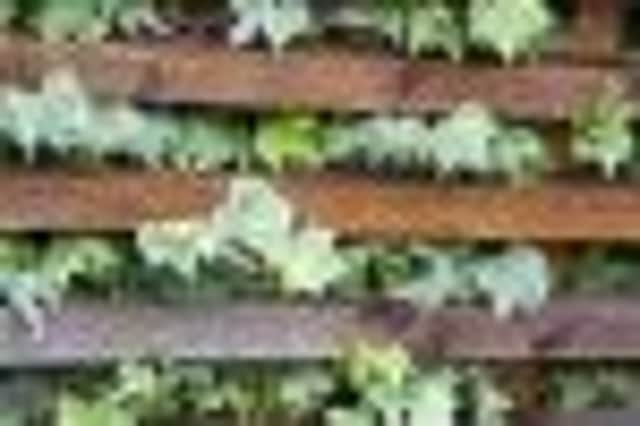Gardens: Alistair and Karen Hagart now have an uncluttered garden that fits their urban lifestyle


Well, no, it’s a city garden which proves you can have everything you want from a smaller outside space, as well as keeping it stylish and uncluttered.
The garden came with the modern house that Alistair and Karen Hagart moved into in Edinburgh’s Murrayfield area. It consisted of grass on a slope and the couple wanted a space that was more user-friendly. They had been used to looking after a large garden but, unsure of how to make a smaller space deliver added value, they turned to landscape designer Paul Church.
Advertisement
Hide AdAdvertisement
Hide AdAlistair says: “We moved from Livingston where we had a detached house in over an acre of garden, which was costly to maintain, both in terms of expense and time. The spec we gave Paul was to design a low-maintenance garden – I sold the lawnmower when we left Livingston.
“We were looking for an extension of the living area at the back of the house – it is a modern house, so we were looking for a modern design. The first plan that Paul brought to us met the spec and was built as designed. The garden is an extension of the family room with the decking brought up to the level of the concertina doors which allows an easy flow from house to garden.”
At 70sq m, the garden is compact, but feels like a light and airy open space. This is thanks to a striking mix of hard and soft textures, light colours and sparing use of plants, favouring those with architectural value. Pale-painted masonry, white corner blocks for plants, and uplighters built into the terrace walls ensure the garden remains a focal point from inside, even in the depth of winter. Yet it is sheltered enough that on a calm day, the couple can still sit outside or even fire up their barbecue.
To start with, the ground was levelled and then backfilled, and Paul then created a half-moon design of decking in larch, one of the most durable softwoods. The sweeping curve carries visitors into the garden from the side of the building. This is the main seating area, and canvas shade sails are suspended over the furniture. The eye-catching and contemporary feature is far more elegant than a parasol. Karen says: “The sails were a great addition as they provide a talking point, but also have a practical use.”
Carrying on the curve, a hip-height terrace also laid with decking could offer extra seats if needed, but is also home to permanent block planters. The risers of the terrace are rendered and painted, offering a surface that reflects light back towards the house. Inlaid in the masonry is low-energy lighting, which the Hagarts find offers a welcome way to extend enjoyment of the garden even when they are inside: “One feature that has become more visible in recent weeks given the darker nights is the effectiveness of the lighting Paul installed in maintaining the connection between the inside and outside,” says Karen. “The design has also created space as the way the raised borders have been constructed has provided seating to keep the decking area uncluttered.”
Sandstone steps cut through the middle of the curve to the gravel of the main terrace, running the width of the rear wall. Along the wall are panels of slatted larch. “This feature softens the wall, and could be used to support plants, though this was not the main reason to include them,” says Paul. The narrow rear bed is punctuated with blue arrow conifers (Juniperus scopulorum). With steel-blue foliage and a very slender growth habit, Paul chose these as they don’t spread like traditional conifers, but provide structure and colour.
Plants are select, as they were not wanted for gardening, so the designer chose ones that bring unusual or year-round colour, but don’t need a lot of work. The bed running along the wall also includes astrantia, in white rather than the usual pink.
Year-round colour comes from hebes; phormium “Bronze Baby” with its warm red-brown leaves; and photinia “Red Robin”, whose leaves change from green to red. In the raised beds he used Allium karataviense, ornamental grass Luzula nivea (snowy woodrush), and Carex comans “Bronze”. More variety of colour and texture comes from the hebes vernicosa and H. albicans “Red Edge”, and the polygonatum (Solomon’s seal) with its double tear-shaped white flowers. Pots hold grasses like Carex buchananii.
Advertisement
Hide AdAdvertisement
Hide AdIn summer, colour comes from hosta “Blue Angel” and “Francee”, the hot-pink flowered pieris, and lavender. The evergreen presence throughout the bed and planters means no area is left bare. More sandstone was cut to fit the curve of the deck at its outmost edges. With its honey and aqua green hues, it ties a cool, clean look together.
Alistair adds: “For a small garden there are a lot of different views and aspects, given the mix of textures, materials and levels, which makes the garden interesting. It is certainly low-maintenance, which has allowed us to make the best of our time, having moved back in to Edinburgh as a lifestyle choice to enjoy the city.”
• Paul Church (0131-449 7997, www.churchlandscapes.co.uk)